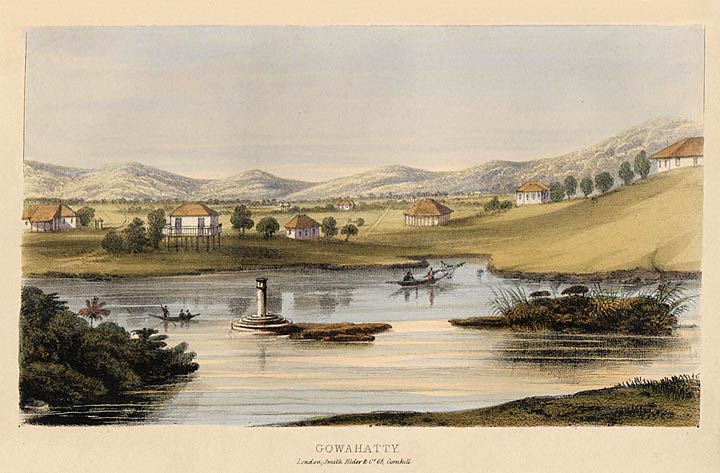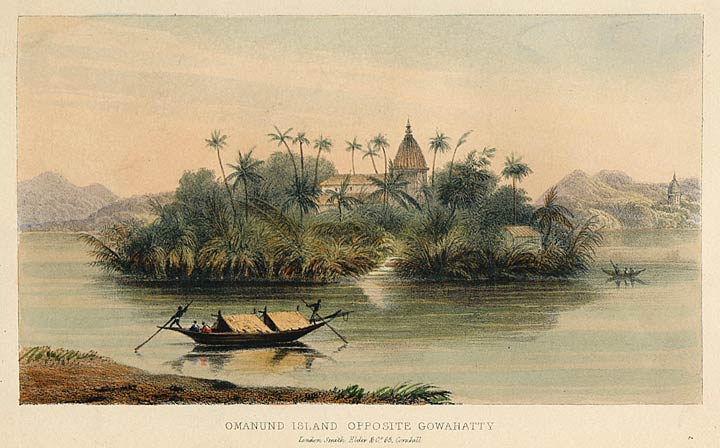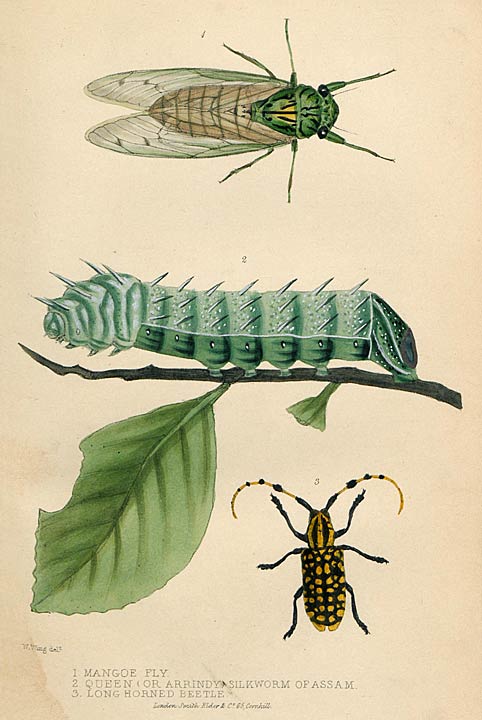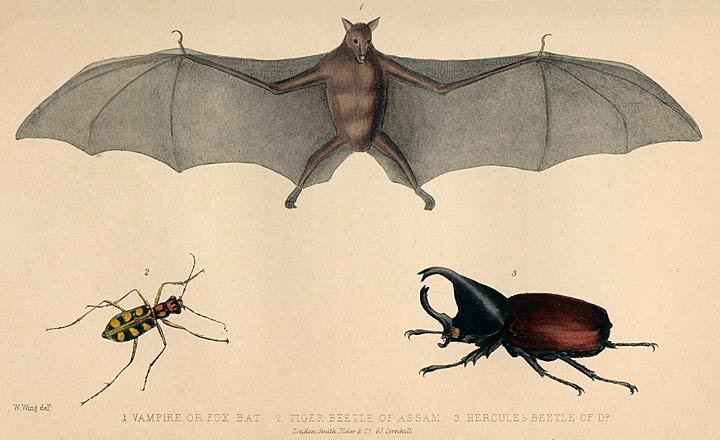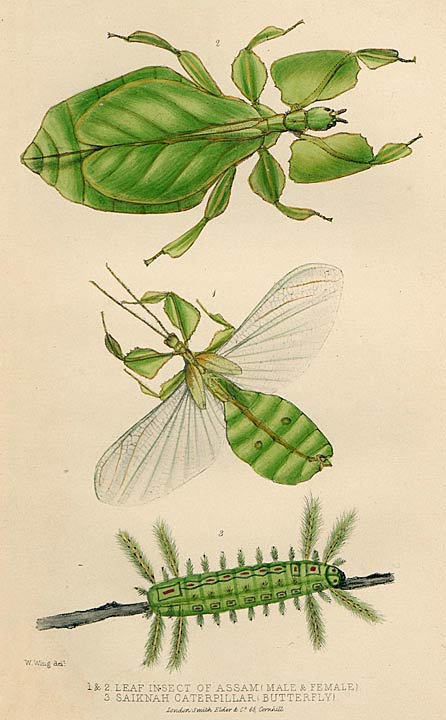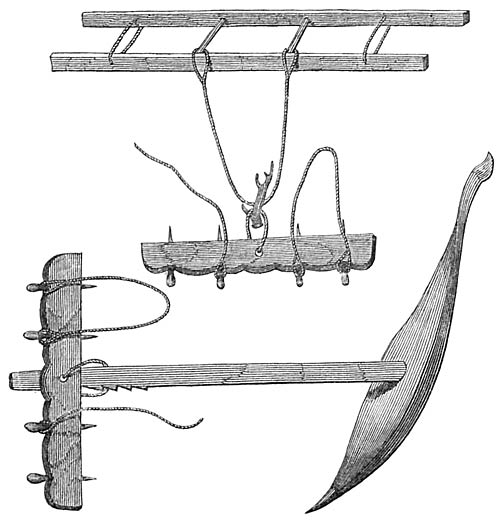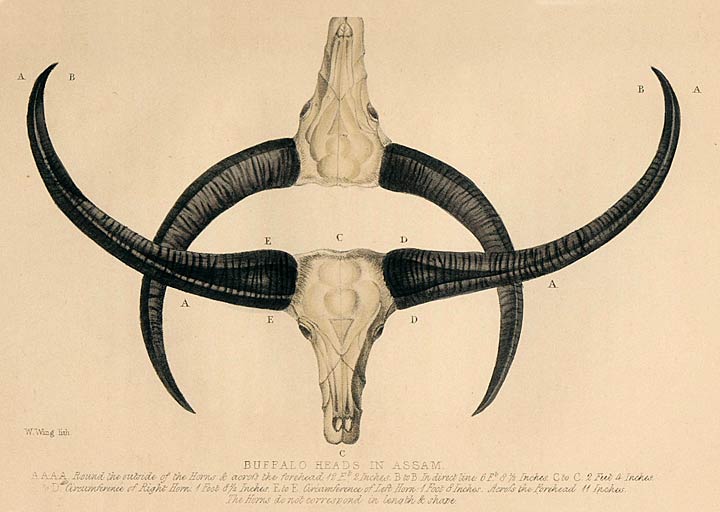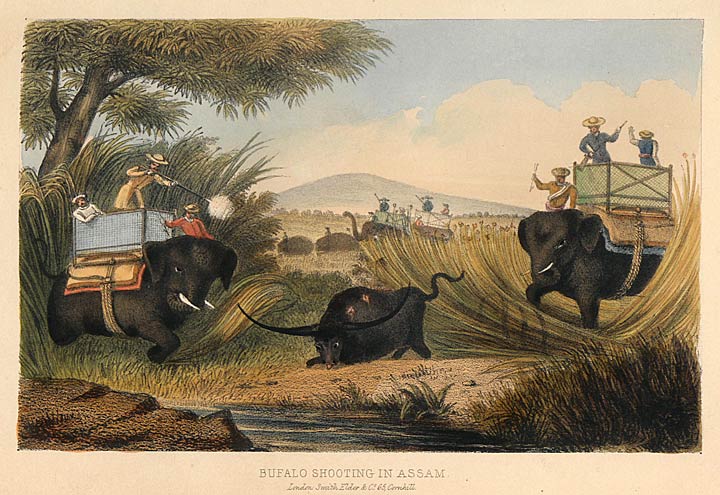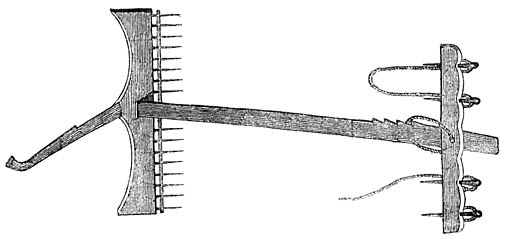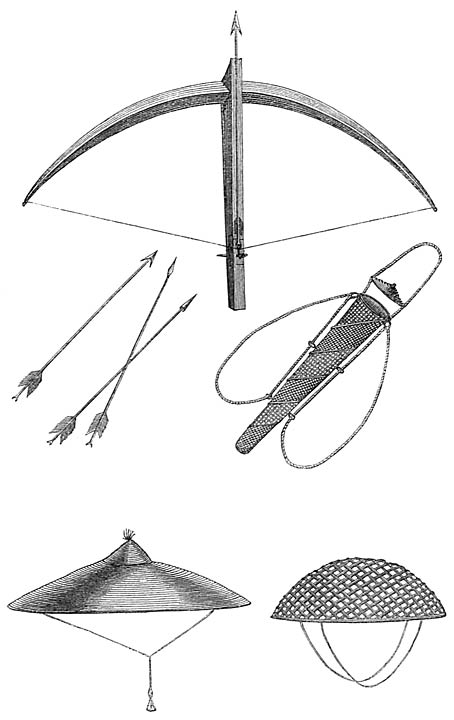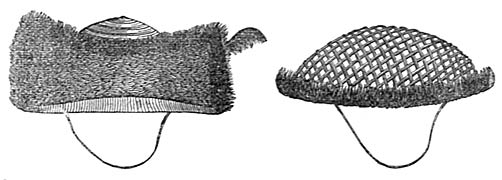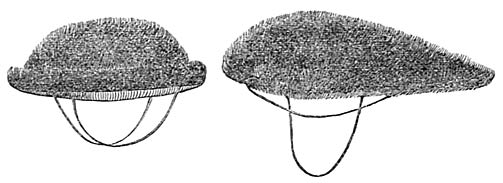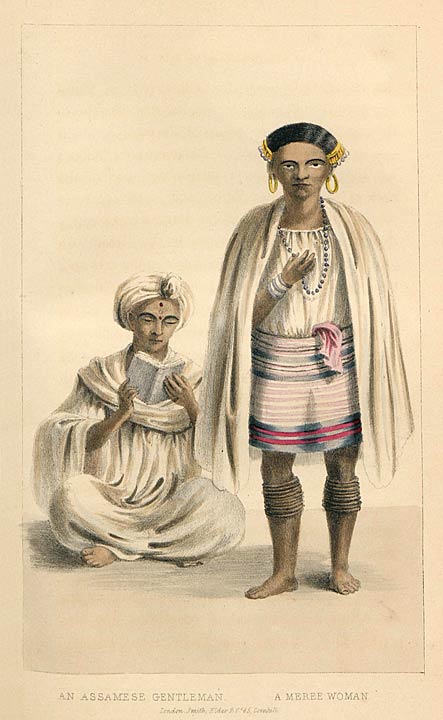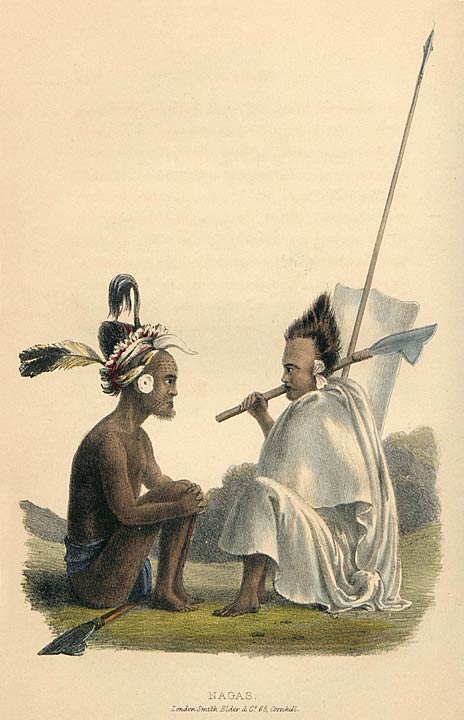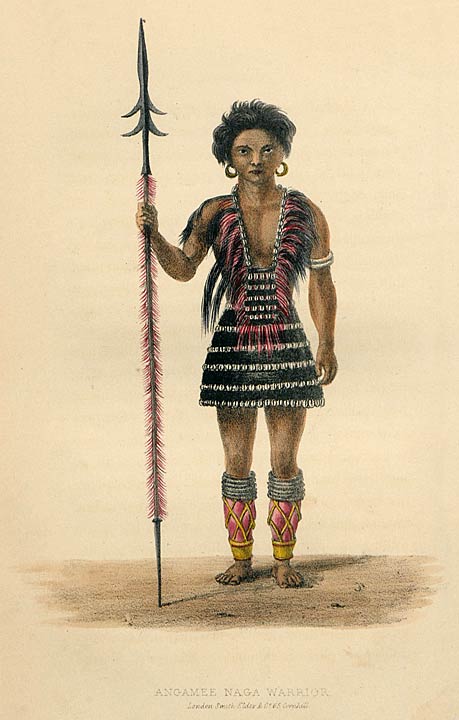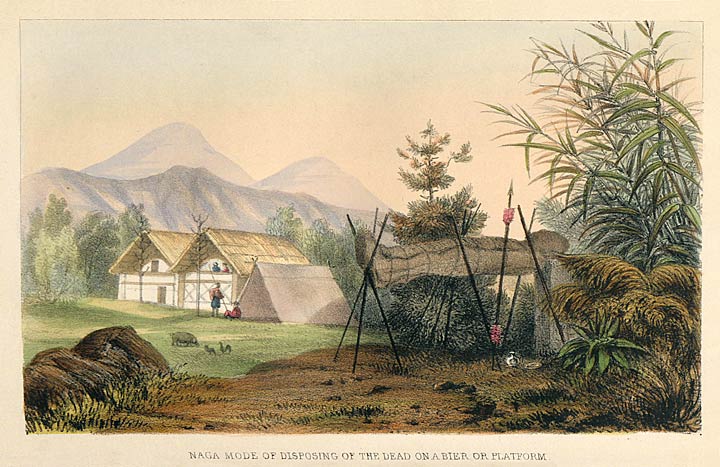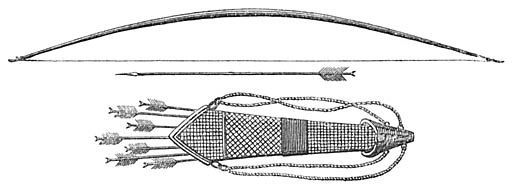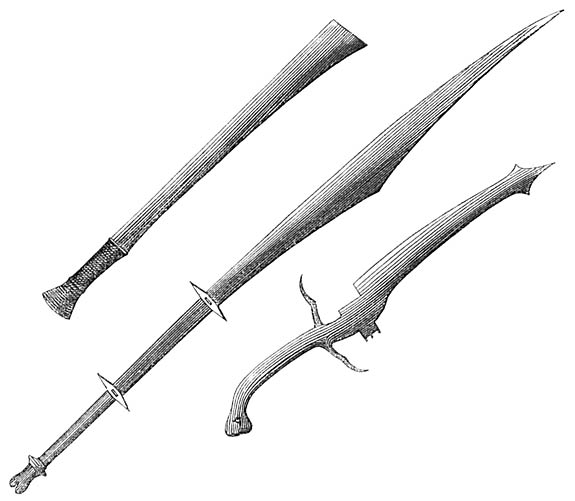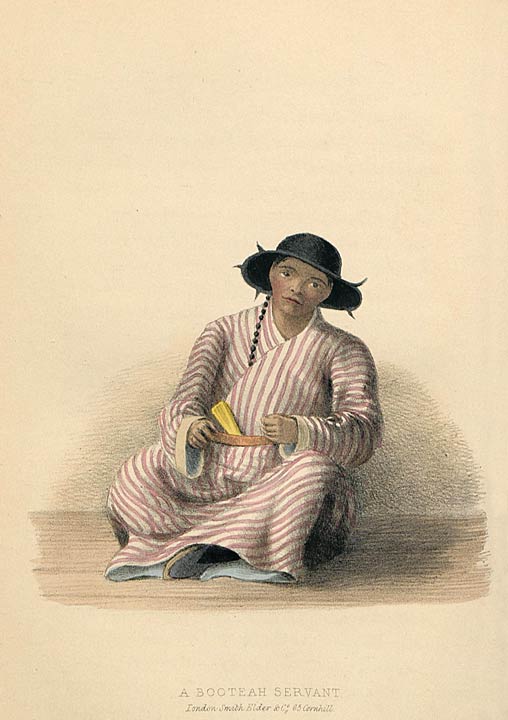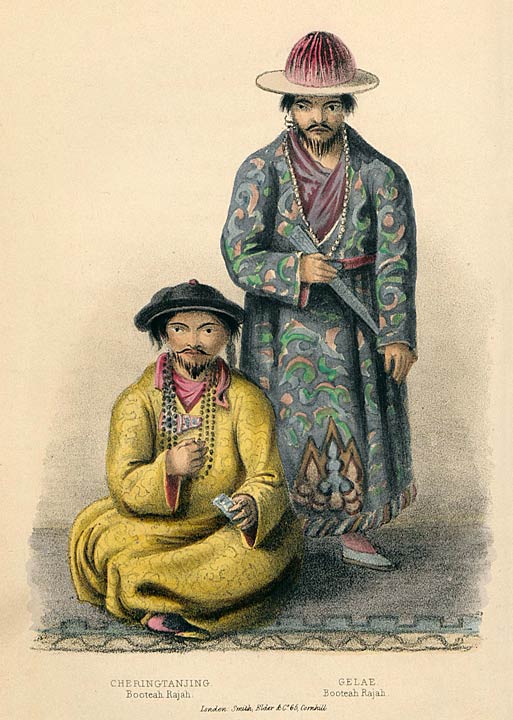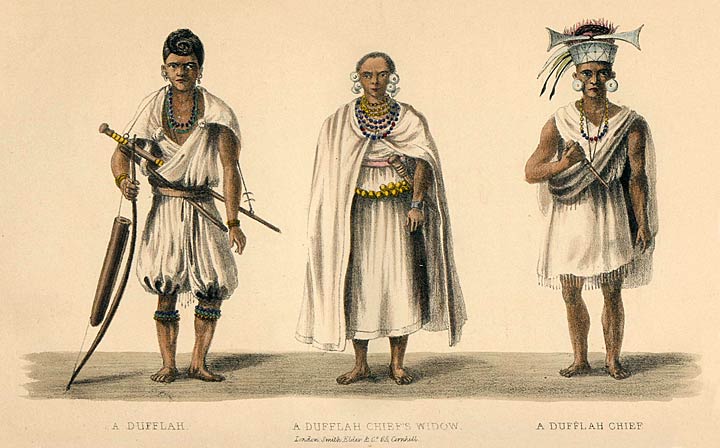Prior.
The Singphoo tribes occupy the country between the
twenty-eighth and twenty-ninth degrees of north latitude, bounded on
the north by the Burrampooter, on the east by the Mishmee mountains, on
the south by the Patkoe range, and on the west by the space from the
mouth of the Now Dehing river, debouching into the Burrampooter in a
direct line to Ningroo, terminating at the foot of the hills south of
the Boree Dehing river. Half of this tract, of about 1,400 square
miles, may be considered hilly, and the remainder undulating. The soil
is rich and fertile, and abundant crops of rice are easily raised both
on the high and low lands. Sugar-cane grows luxuriantly; [60]tea is
likewise found, and every part of the country is intersected by fine
clear streams. The most productive corn tracts are the valleys of the
Teerap, Namroop, Boree Dehing, Now Dehing, Mudhoopanee, Tengapanee, and
Kurempanee. Almost the whole of this country, at the present time, may
be said to be one immense forest, but about sixty years ago, or
previous to the arrival and settlement of the Singphoos within the
Assam frontier, it was considered, from the great extent of
cultivation, a fertile, salubrious region. The Singphoo population was
estimated in 1838 at about 6000 persons; but in the absence of a
regular census, we can form no accurate estimate of their real numbers.
At the present day their communities are very small: probably 6000
persons would not be found scattered over the whole frontier north of
the Patkoe range. In the vicinity of the Tengapanee, the following
Singphoo chiefs reside:—Niphoonnong, Tangsangtau, Jowbongsang,
Nidong, Koonkie, Phoop, Oompheedor, Luttora, Ong, Keemingdoo, Niyang,
Lajee, Mannong, Nakinchong, Nisah, Koomiyunglah, Ninayong, Jooloo,
Nisah Doboon, Jowna, Wakhut. On the Now Dehing; Komonjong, Wakhut,
Soanjang, Kamchowjow. On the Mudhoo and Jengloo-Panee; Luthaon-Jowbong,
[61]Simaen, Moolan, Jowken, Nisam, Phoinchee,
Seerolasein, Mokhoh, Nidhen Lekhala, Nizen Chowkhen. On the Boree
Dhing; Kinglong, Chamsong, Ningroola, Beesa, Lakhoom, Noobrong, Lajong,
Seong, Bathamgam, Moongong, Jowkeem.
Each of the different Singphoo tribes is governed by a
chief, designated a Gaum, whose authority over his clan is nearly
despotic, and entirely independent of the other chiefs. The general
body of clans seldom combine, except for purposes of plunder.
Occasionally, however, some chiefs, endowed with superior energy,
acquire influence over the rest; and this would appear to have been the
case with the Beesa Gaum, when the late Mr. Scott, agent to the
Governor-General, entered into a treaty with the Singphoo chiefs. At
that time the Beesa Gaum was the most intelligent and influential of
the chieftains, and was publicly recognised as the agent through whom
the sentiments of the British Government should be made known to the
different tribes. In other respects he had no controlling authority,
and was regarded by his brother chieftains as merely their equal. On
the invasion of Assam by the Burmese, the Singphoos joined the force,
and partook of their plunder; in [62]fact, they had no alternative:
their only option was to plunder others or to be plundered.
Prior to the conquest of Assam by the British power, the
Singphoo tribes had been accustomed to make annual incursions into the
province, for the purpose of obtaining slaves and plunder; but on the
establishment of a British force at Suddeah, this practice was
effectually restrained. From this circumstance arose their dislike to
our power, which readily disposes them to listen to any adventurer who
holds out to them the prospect of driving us out of the country; for
with the reckless and short-sighted policy of barbarians, they never
calculate the consequences of a revolt, but think that if the British
troops were defeated, and our influence annihilated, all their desires
would be accomplished.
The Burmese having been driven from the province, in
1824–25, by our troops, and the Singphoos completely subdued, it
became necessary to adopt measures for the establishment of our future
intercourse with the latter; and for this purpose, on the 3rd of May,
1826, a treaty was entered into with them, granting them terms they had
no reason to expect. The following is a copy of the compact:
“Whereas we, the Singphoo chiefs named Bam,
Komjoy, Meejong, Jow, Chowkhen, Jowrah, Chow, [63]Chumun,
Neenjun, Tangrang, Chowbal, Chumta, Chowrah, Chowdoo, Chowkam,
Koomring, &c., are under the subjection of the British Government.
We execute this agreement to Mr. David Scott, the agent to the Governor
General, and hereby engage to adhere to the following terms, viz: 1st.
Assam being under the sway of the British Government, we and our
dependent Singphoos, who were subjects of the Assam state, acknowledge
subjection to that Government. We agree not to side with the Burmese,
or any other king, nor to commit any aggressions whatever; but we will
obey the orders of the British Government.
“2dly. Whenever a British force may march to
Assam, to protect it from foreign aggression, we will supply that force
with grain, &c.; make and repair roads for it, and execute any
order that may be issued to us; and we shall, on our doing so, be
protected by that force.
“3rd. If we abide by the terms of this
agreement, no tribute shall be paid by us; but if any Assam Paicks, of
their own accord, reside in our villages, the tax on such Paicks shall
be paid to the British Government.
“4th. We will set at large, or cause to be
liberated any Assam people whom we may have [64]seized,
and they shall have the option to reside wherever they please.
“5th. If any of the Singphoos rob any of the Assam
people residing in our country, we will apprehend the former, and
surrender him to the British Government; but if we fail to do so, we
will make good the loss thus sustained by the latter.
“6th. We will govern and protect the Singphoos
under us, as heretofore, and adjust their differences; and if any
boundary dispute occur amongst us, we will not take up arms without the
knowledge of the British Government.
“7th. We will adhere to the terms of this
agreement, and never depart from them. This agreement shall be binding
upon our brothers, sons, nephews and relatives in such way as the Agent
to the Governor-General may deem proper. We have executed this
agreement in the presence of many. Written at Suddeah, 5th May, 1826,
A.D.”
The Singphoo country remained undisturbed until the year
1830, when the invasion of Wakim Koomjoon, from the province of
Hookong, on the Burmese side, took place, and was promptly repelled by
Captain Neufville. On this occasion, the Luttora and Tengapanee
Singphoos took part with the invader, and the Beesa Gaum with the
[65]British authorities. The assistance of the Beesa
Gaum does not appear to have been of a very active nature, but his
conduct was nevertheless approved by the Political Agent, and rewarded
by Government. He was, however, shortly afterwards dismissed from the
situation of Sunzatee, and Zalim Sing, a Soobadar of the Assam Light
Infantry, who had greatly distinguished himself under Captain
Neufville, was appointed to the office. Bijee Nath Sing, a Soobadar of
the Assam Light Infantry, succeeded him in 1839.
In 1835, the attack of the Duffa Gaum upon the Beesa
took place. This compelled the British Government to interfere for his
protection, and to avenge the massacre of its subjects; but although
the attacking party came from Hookong, the contest was in reality
between the Khakoo Singphoos, under the Luttoora chief (who espoused
the Duffa’s cause), and the Now Dehing and Booree Dehing
Singphoos, on the side of the Beesa; for the Duffa only brought fifty
muskets with him and one hundred followers, the remainder of his force
being collected within the British boundary.
The feud between the two rival chieftains, the Duffa and
the Beesa, arose in 1823 A.D., two years before
the assumption of the sovereignty of Assam [66]by the
British Government. A Singphoo chief of rank, named Likhee Khandoo, who
had lately come over from Hookong, had proposed to the Beesa Gaum that
the Singphoos, in conjunction, should attack the Bursenaputty, or chief
of the Muttucks. The Beesa chief replied that he would willingly join
provided the Duffa Gaum was of the party; the latter was applied to,
but refused to engage in the enterprise; nevertheless the attack was
made by the Singphoos, but was repulsed with severe loss to them, the
Muttucks having received secret information which enabled them to
prepare to receive the assailants. The prior intelligence of the attack
which the Bursenaputty had received, was ascribed, whether justly or
unjustly, to the Duffa chief’s agency. Accordingly, in a spirit
of revenge, the remaining Singphoos attacked his house, wounded his
wife (who died from the effects of her wounds), and killed some of his
people. It is not certain that the Beesa chief was present at this
outrage, but as the party went from his house, there can be little
doubt of his connivance at the transaction. After this the Duffa chief
withdrew into the district of Hookong, under Burmese control; and
although repeatedly invited by the British authorities to return and
resume his territory, he never could be prevailed on [67]to do
so. Nor did he ever make application to obtain redress for the injuries
he had sustained from the Beesa chief prior to the conquest of Assam by
the British Government, and it was evidently never his intention to
apply. Indeed, it would have been incompatible with Singphoo notions of
honour that a chieftain should have obtained redress in this manner
without retaliating upon his enemy. With this latter view, ever since
his retreat from Assam, he had been gradually labouring to extend his
influence amongst the Singphoos, across both the Burmese and Assam
sides of the boundary line; and possessing the advantage of birth,
superior connections, and a reputation for liberality, he at length
succeeded in establishing an ascendancy paramount to that of the Beesa
chief: which had latterly declined, owing to his connection with the
British Government. The Beesa chief, and those dependent upon him, had
been compelled to give up the Assamese who returned from slavery in
Burmah—a measure extremely repugnant to the Singphoos, dependant
as they were upon the Assamese for the means of subsistence.
Matters stood in this position up to July 1835, when the
Duffa Gaum, having obtained decided influence, planned an expedition
into the Beesa’s [68]territory, and appearing there unexpectedly,
surprised and plundered his village, murdered his wife, his son’s
wife, and ninety of his people: thus retaliating in a far greater
degree the injury he had sustained. On hearing of this outrage,
Lieutenant Charlton ordered out a company, and instructed the Soobadar
to inform the Duffa Gaum that he must forthwith quit the Assam
boundary, and that, on reaching the frontier, any complaint he had to
prefer against the Beesa chief would be promptly attended to. The Duffa
chief refusing to comply with the mandate, Lieutenant Charlton was
obliged to employ force against him; but the troops under Lieutenant
Charlton’s command being insufficient for the purpose, three
months afterwards (in November 1835) the political agent in person
moved to his assistance with two hundred and fifty men of the Assam
Light Infantry.
The Duffa Gaum, anticipating an attack, had taken up a
strong position in the stockades on the Menaboom hills. Prior to
resorting to hostilities, every exertion was made to induce the chief
to come to terms, and a three days’ truce was granted for this
purpose. The Khamtee chiefs and the Bursenaputtee of Muttuck, who
accompanied the political agent as auxiliaries on this occasion, were
[69]required to escort the Duffa Gaum to the camp of
the Political Agent as a security that his person would be respected,
and that he would be permitted to return unmolested should no
satisfactory result follow the meeting. The Duffa Gaum, however, being
still apprehensive of treachery, could not be prevailed upon to attend
the conference, until the Political Agent consented to meet him at a
spot one hundred and fifty yards distant from his fort, with an escort
of only a havildar and twelve soldiers. The escort having been
scrupulously counted, the chief at last came out with a similar number
of armed followers. His demeanour was most abject: he and his whole
escort sunk down upon their knees, and taking a handful of the earth,
he kissed it and said that the Company was Lord and Master thereof. He
then proceeded to speak of the injuries he had sustained from the Beesa
Gaum. In reply, he was told that he had no reason to complain of the
British Government, as he had never represented the conduct of the
Beesa chief to any of the functionaries, and that it could not be
expected that the Government should take cognizance of acts which had
occurred in 1823, prior to its assumption of the sovereignty of Assam.
The injuries which the British Government had sustained from him were
[70]then recapitulated: the murder of its subjects,
the plunder of their property, and the Duffa Gaum’s stubborn
persistence in retaining his position in the face of repeated
injunctions that he should withdraw from the territory within the Assam
boundary. It was further brought to his recollection that the British
Government had repeatedly offered him repossession of his territory,
provided he came in a peaceable manner, but that it was incompatible
with its dignity to allow him to attempt to extort by force that which
had been given spontaneously. He was then required, First, to make
good, by an annual instalment in money, elephants’ teeth, or gold
dust, the loss of 8000 rupees that our merchants had sustained by his
treacherous attack on Beesa: furnishing security, or a hostage, for the
fulfilment of his engagement; and, Secondly, to dismiss the auxiliary
Singphoos whom he had brought from the Burmese territory: and as a
security for their not returning he was to give up their arms. The
Duffa Gaum agreed to both these propositions, apparently in the most
joyful manner, and promised faithfully to come in the following
morning; but the next day he sent a letter into camp referring entirely
to his ancient dispute with the Beesa chief, and making no allusion
whatever to the terms proposed to him. [71]Upon this, the British
force took up a position within five hundred yards of his stockade; but
the Duffa Gaum’s agent immediately came out and said, that if the
Political Agent would advance alone to a place within one hundred and
fifty yards of the fort, the chief would come out and accompany him to
camp. The Political Agent complied with the request, remained at the
appointed spot half an hour at considerable personal risk, and called
upon the Duffa Gaum to fulfil to his promise. The answer given was,
that the Duffa Gaum had no confidence in the sincerity of the Political
Agent, as Wakutchangnang had sent him a flint, powder and ball, the
evening before: which was equivalent to an intimation that his
intentions were warlike whilst proposing peace. The Agent urged in the
strongest manner that no such message had been sent; but finding the
Duffa Gaum immovable, hostilities were reluctantly resorted to. A
signal was given to the battery, and the fire commenced; the stockade
was carried, and the Duffa chief fled beyond the frontier.
Not the slightest doubt was entertained of the
individual desire of the Duffa chief for peace; but the Khamtee chiefs,
being irritated by certain proposed innovations in 1834—such as
taking a census [72]and taxing them—were the first, it is
believed, to call in the Duffa chief, with a view of exciting troubles
and obstructing the maturity of our plans; and thus was the negotiation
marred.
In the year 1838 public tranquillity was again disturbed
by a feud between the Peshee and Let chiefs, which compelled the
British Government to interfere and punish the former: who, contrary to
his agreement, persisted in attacking the latter. The Luttora chief
likewise violated his compact, by giving aid to the Peshee chief, and
was driven from the Company’s territory.
Though the Tengapanee Singphoos did not arrive in time
to join in a body with the Khamtee chiefs, in the attack made on the
post of Suddeah in January 1839, their disaffection was apparent in
their unprovoked attack upon, and plunder of, the villages in the
Saikwah district, when they carried off many Dooaneahs. In consequence
of this outrage, a detachment of troops visited in November 1839, the
principal villages of Inshaw, Dobom, Inban, Luttora, Koomkie, and Tang
Sang Tang; situated at the foot of the Mishmee hills, between the
Kerempanee north, and Mena Boom hills south, in the vicinity of the
Tengapanee, which takes its rise in the Mena Boom hills south. On this
occasion the [73]whole of the chiefs were assembled, and the
heinousness of their late conduct explained: fines were imposed in
proportion to their means, and their submission and pledges required to
an extent never before obtained, besides the restitution of most of the
Dooaneahs carried away from Saikwah. The confederacy between the
Singphoos and Kamtees was broken up, and the expulsion of the Deerack
Tawah Gohain effected, with the loss of his village and a quantity of
grain.
In November 1841, considerable alarm pervaded the
north-east frontier, owing to a report that the Tippum Rajah, aided by
the Burmese and Singphoos from both sides of the border, meditated an
incursion into Assam. To remove this impression, a tour was made by the
Political Agent with a company of the Assam Light Infantry, a body of
Golundaz, and two three pounders carried on elephants, through the
greater portion of the Singphoo territory. The route pursued was from
Saikwah up the Burrampooter river to the Tengapanee; and on passing the
villages of Kinglong, Dohing Koomkee, the principal chiefs, Neesaka of
Jusha, Ong of Luttora, Labing of Dobom, Tang Sang Tang, Koomong of
Koomkee, and Samnong, son of the Wakhet chief, paid their respects.
From thence [74]the party proceeded up the bed of the Tengapanee,
by the site of the former village of Luttora, on to Naing and
Meerappanee, and commenced the ascent over the Mena Boom hills: a most
trying undertaking for elephants, as they had to travel along a narrow
ridge in some places only a few paces wide, and entirely composed of
loose stones; the sides frequently presenting dangerous precipices. It
was in descending this ridge that the laden elephants encountered the
greatest difficulty; yet they managed to get down without the necessity
of dismounting the guns, and reached Beesa and Ningroo in perfect
safety. The Singphoos thus learned the folly of trusting to their
stockades in their fastnesses, when guns could be brought against them
by moderate exertion and ingenuity. It was hoped that this tour would
also tend to repress the feuds so constantly arising amongst
themselves; seeing that justice could be administered even in retreats
the most secluded and difficult of access. But this expectation was not
realized; for in the year 1842 the Tippum Rajah (brother of Jegessur
Sing, the last rajah of Assam, said to be now governor of Hookong and
Mogong) sent the Beesa chief six pounds of needles, half of which were
broken, to be distributed by him amongst the Singphoos: a [75]token or
signal of alliance and preparation for war. This intimation was
followed up in January 1843 by an attack on a party consisting of one
Jemadar, one Havildar, one Naick, and twenty Sipahees located in a
small stockade at Beesa. Some previous altercation had occurred between
the Jemadar and the Beesa chief regarding the repair of the stockade,
which not having been effected, the Jemadar had contemptuously called
the Beesa chief an old cow, and in return vengeance was vowed in
intelligible terms. After holding out for some days, three Sipahees
being killed and three wounded in the defence, the Jemadar was
unfortunately induced to surrender himself and party prisoners of war;
the treacherous Singphoos having assured him that the posts of Ningroo
and Koojoo had fallen into their hands, and our troops been totally
defeated. Trusting to their mercy and honour, he caused his men to
cease firing; and oaths were freely taken in support of promises of
good and honourable treatment; but the instant the Singphoos gained
admittance into the stockade, the Jemadar and the whole party were
disarmed and bound. The next morning the Jemadar and Havildar were led
out by the Singphoos and tied up to a tree, and fired at; after this
they were hewn to pieces with a short sword, [76]on the
same spot where one of the Singphoos had been shot by the Jemadar when
in possession of the stockade. Nine of the Sipahees were sold into
slavery, some to Hookong and Burkhamtee. Thus signally did the
Singphoos gratify their revenge, at the commencement of the irruption
or attempt to break through the line of outposts and lay waste the
whole country.
Their second and third attacks on the Koojoo and Ningroo
stockades, defended by European officers, were completely frustrated.
The Koojoo stockade was besieged for some days, but a sally being made
on the enemy whilst the Singphoos were at dinner, they were defeated
and fled in the utmost consternation. The Ningroo stockade was likewise
at night suddenly attacked and taken by surprise, but after a short,
sharp struggle, in which several lives were lost, the Singphoos left
the stockade in greater haste than they entered it.
The Tippum Rajah’s sister was married to the late
king of Ava, and she is supposed to be in favour with the present king.
It may be owing to her influence that the Tippum Rajah is reported to
be now Governor of Hookong, to take advantage of any opportunity to
invade Assam. Scarcely a year passes without some such reports being
spread [77]throughout the province, and there is great reason
to believe that the Singphoo insurrection of 1843 was raised at the
suggestion, or at least through the connivance of the Rajah; as many
Burmese or Shans under his jurisdiction crossed the frontier and joined
the insurgents in the hope of plundering the province. Had success
attended their first attempts, it cannot be doubted but that many more
would have soon followed their example, in the speedy removal of slaves
and property from Assam. But the real origin of the insurrection was
the occupation of the Koojoo tea garden and other tea tracts. The
constant desertion of the Dooaneah slaves and dependants, who are the
people chiefly employed in cultivation under the Singphoos, besides the
advance of civilization consequent on the establishment of a
considerable village at Jeypore with European residents, was the source
of much heart-burning. The occupation of Muttuck, formerly under native
management, must also have proved distasteful to a savage people
possessing a wild country and delighting in extensive hunting-grounds.
These circumstances, aggravated by frequent quarrels with the Sipahees
at Ningroo, the unauthorized apprehension of two Let Singphoos by the
Jemadar, and a desire of revenge for the execution, [78]many
years ago, of Ningroola Gaum’s kinsman, certainly contributed to
produce the insurrection of 1843.
Viewing the nature of our connection with the Singphoos
generally, it must be acknowledged that the balance of advantage had
been decidedly in their favour; for while we have been called upon to
fight their battles, little or no assistance has, comparatively, been
afforded us by them. Being a rude, treacherous people, little faith can
be placed in them; neither can we expect they will be influenced or
bound by any treaties not in accordance with their own views: in fact
they have in no respect fulfilled their obligations to the British
Government.
The Singphoo country is eminently unfavourable to the
operations of regular troops, owing to its mountainous character,
unrelieved by plains or table lands, the want of roads, the extreme
scarcity of provisions, the absence of local means of transport, and
above all the unhealthiness of the climate. The Government is likewise
put to a great expense without commensurate benefit, for in such a rude
and barbarous state of society revenue cannot be collected without the
employment of military force; and this is not always adequate to
[79]the success of hostile operations, because of its
paucity and the advantage afforded to the natives by the natural
defences of the country: of which they are not slow to avail
themselves.
In reviewing the different tribes of Assam, it may not
be out of place to offer a brief sketch of one or two of the
chieftains.
Wakut-chang-nang is the son of a Singphoo chief who
submitted to Captain Neufville in 1825, and received a present of a gun
and other articles from him, which he requited by firing upon the
captain a day or two afterwards. The ball missed Captain Neufville and
went through Lieutenant Kerr’s hat without doing him any injury.
Subsequent to this, Wakut-chang-nang absconded to Hookong within the
Burmese boundary, and only returned in 1835 to the Assam territory.
During his sojourn within the Hookong territory he is stated to have
committed several murders; and with the money accumulated by crime and
robbery, he has been enabled to marry the Beesa Gaum’s daughter.
From his having been the principal agent in breaking off the
negotiation with the Duffa chief, and consequently the cause of the
subsequent bloodshed, he was imprisoned during 1836–37 at
Bishnath. He is now residing at Beesa, and is considered, as
[80]heretofore, an intriguing, dangerous character.
The Beesa Gaum, having been implicated in the rebellion of 1843, is now
a state prisoner for life; he is nearly blind, and his career may be
said to have closed, as it is not probable he will survive many years.
He was supposed to be a man of good sense and to possess considerable
information regarding border politics, but of no enlarged capacity or
superior energy of character, and totally incapable of forming those
comprehensive designs which have been attributed to him. He is not of a
warlike character. Most of his battles have been fought by others: for
a Singphoo chief is not expected to head his troops in action.
Nevertheless his disposition is sanguinary, and it is said his career
has been marked by blood and treachery in a greater degree than usual,
even amongst the Singphoos.
The Shan is the written character used by the Singphoos,
and their language is distinct from any of the neighbouring tribes:
they write on leaves and a peculiar kind of paper. As yet no European
has sufficiently studied the language to appreciate justly the Singphoo
literature, or to prepare elementary works for the guidance of others.
Nor are we aware of there being any written works in the language
either historical or theological. As [81]civil members of society
they are anything but good subjects, from their excessive laziness,
immoderate addiction to opium, and general uncertainty of character.
They are so indolent and improvident, that notwithstanding they have
the most fertile soil in Assam, which yields fruit with little labour,
and might be made to produce an abundant crop—notwithstanding,
too, their freedom from taxation, grain is always so extravagantly
dear, that during several months in the year the people are reduced to
subsist on yams and other roots found in the jungles. Almost the whole
of the field work is performed by the women and slaves, while the men
delight in lounging about the villages, and basking in the sun, when
not engaged in hunting or war.
The religion of the Singphoos appears to be a mixture of
all the various idolatries and superstitions of the natives with whom
they have intercourse. They seem to have no fixed principles common to
the whole tribe. Their ostensible worship is that of Guduma, whose
temples and priests are to be found in all their principal villages.
They are also in the habit of deifying any Singphoos who may chance to
be killed in action during a foray upon some other tribe or village,
and of sacrificing to [82]them as to their penates. On emergencies,
such as famine, pestilence, or danger, they make offerings to the
“Ning Deota,” God of the Elements, called also
“Ningschees;” sacrificing buffaloes, hogs, and cocks. The
skulls of the buffaloes so offered are afterwards hung up in their
houses as mementos of their own piety.
Their funeral ceremonies are simple. The poorer classes
burn or bury the body, according to the previously expressed wish of
the deceased, and invariably make to the deity an offering of a pig,
fowl, or fish, through their Deodhies or priests. On the death of a
chief, numerous ceremonies are performed: the body is detained until
all the friends of the deceased can be assembled, when buffaloes, pigs,
and deer are sacrificed, a grand feast is given, and spirituous liquor
distributed to the company. The corpse is then committed to the earth,
the priest chants a prayer for the deceased, a clay tomb is raised over
the remains, and the grave is encircled with a bamboo fence. Sacrifices
are always offered up on the death of every Singphoo, according to the
means of the surviving relatives; no matter whether death be caused by
accident or war, or in the course of nature.
Polygamy, without restriction, prevails among the
[83]Singphoos, and they make no distinction between
the children born of Singphoo women and those born of foreign or
Assamese women. They reject with horror the idea of infanticide, under
any shape or pretext. Marriage is only forbidden with a mother or
sister: they may marry stepmothers, brothers’ widows, or any
other relative. In the marriage ceremony the bridegroom has to present
the parents of the bride with a Khamtee Dhao, or short sword, a velvet
jacket, a silk Dhota, and a slave; the rich give gold and silver,
buffaloes, and as many slaves as the wealth of the bridegroom will
permit. The bridegroom has also to furnish a marriage feast to the
friends and relations of the bride; and after the Deodhies or priests
have performed a certain religious ceremony, the bride is delivered
over to the bridegroom, and the jewels, &c., which are on her
person, are returned to her parents.
If a man commits adultery, he is obliged to pay damages
according to the demand of the injured husband, in slaves, buffaloes,
dhoties, swords, money, or beads; and if he cannot pay the damages, he
pays the penalty of his crime in confinement. No damages are demanded
for the violation of an unmarried woman or virgin; [84]but in
the event of her being found pregnant, the ravisher has to give the
parents three slaves and one buffalo, and the issue is claimed by the
man. It is optional with himself to marry his victim, or not. Theft is
punished by exacting from the thief double the value of the property
stolen.
The Singphoos entertain strange ideas of honour and
revenge. Compatibly with their customs and rude notions of religion, a
Singphoo chief could not ever abandon, without dishonour, the
application of the lex talionis to one who had murdered his
relative; although, from circumstances of policy, or deficiency of
means, he might postpone the gratification of his vengeance to an
indefinite period. A mistaken feeling of religion, combined with
private affection for the deceased, fully accounts for this perverted
state of mind. The Singphoos imagine that the soul of the murdered
individual will torment them until his manes are appeased by the death
of one of his enemies; and further, that the anger of their deity would
be roused should an opportunity of retaliation be neglected. Nor is the
retribution to be limited to the actual perpetrator of the homicide. If
death be occasioned by violence committed, or supposed to be committed
by any one, the relations are never appeased until they have murdered
one [85]of the family to which the murderer belonged. An
innocent person is thus often murdered, who is quite ignorant of the
injury committed by his tribe or family.
The houses of the Singphoos are generally nothing but
long sheds, roofed in with grass or bamboo leaves, and the walls
composed of split bamboo. The floor of the dwelling part is raised
about four feet from the ground; and the entrance forms an extensive
porch, in which are congregated pigs, fowls, household and agricultural
implements, and where women may generally be seen pounding rice. These
buildings are sometimes one hundred feet long, and divided into
compartments allotted to several families. Occasionally immense houses
may be seen, which are occupied by powerful chiefs; the timbers of
these buildings being of such enormous size and length as to render it
a matter of surprise that they could have been erected by mere manual
labour. At the burning of the Ningrang chief’s house, when the
village was surprised by our troops in 1843, the officers remarked that
the posts were of prodigious diameter and length; and it was regretted
that war rendered it necessary to destroy such a magnificent residence.
The mansion was entered by a flight of several steps leading up to the
floor, and was divided into numerous rooms by partitions of split
bamboo. [86]
The Singphoos have nothing approaching to what we call
government: each chief is independent, collecting no revenue, nor
directing in person any force, although he may influence the movements
of others. The Singphoos are of a tawny complexion, and a cunning
expression, with long bodies and short legs. They are implacable,
cruel, and treacherous; stealing upon and murdering with the short
sword at night those who have offended or injured them; and are ever
ready to coalesce for a foray, if there is a prospect of success.
Casualties that occur from the contentions of one tribe with another,
murders resulting from private jealousy, the difficulty of procuring
food, and exposure to the inclemency of the weather, help to keep the
population scanty all over the north-east frontier. In fact, the great
cause of the thinness of the population is the want of food, arising
from the absence of productive industry. The unsettled and lawless
state of society among the Burmese and Singphoos appears likewise to
operate in retarding the extension of trade; and this evil cannot be
rectified until these tribes are brought more completely under
subjection to the British Government. That once effected, a mart might
be formed at our extreme boundary; though the scantiness of the
population [87]in these regions would probably for some time
prevent the establishment of a very brisk trade.
Hookoom is distant from Suddeah about 200 miles; a
miserable, desolate, backward country intervening: in fact, almost an
entire jungle throughout. At Moonkoom there would be a larger field for
commerce, as water communication by the Irawaddy is facile. Broad
cloths, &c., could probably be conveyed thither cheaper, viâ
Rangoon, than from the Burrampooter. The same obstacles exist to
opening a trade between Assam and the provinces of Yunan, owing to the
greater proximity of Yunan to the Burmese empire. By all accounts a
considerable trade is carried on between the two countries, viâ
Bamow: a Burmese town within twenty miles of the confines of Yunan; and
from the facility of transport which the Irawaddy affords, we may infer
that British goods could be supplied at a cheaper rate, and with
greater safety, from Rangoon or from Moulmein through the Sangha, than
could be effected from Assam. The poverty of the people on this part of
our frontier is such that scarcely any one can afford to buy woollens,
excepting the chiefs, and even those persons generally receive them as
presents from the officers of Government. It would therefore be
desirable to send up articles of [88]less value. The articles chiefly
in demand are salt, cloths, tobacco, opium, knives, needles, cups and
saucers, basons and plates.
In 1828, by way of experiment, and to test the
possibility of reviving trade, a Government investment of woollen goods
to the amount of 4000 rupees, was sent up to Suddeah; but it actually
took eight years before the whole stock was sold off, and it would not
then, probably, have been disposed of, had not the price been reduced
thirty per cent. below prime cost. It was sold during the first and
second years of its appearance in the market, at prime cost; afterwards
at a reduction of ten, twenty, and thirty per cent. Since then, a
trade, such as it is, has been established at Suddeah by native
merchants, at considerable risk; for the Government will not undertake
to give compensation for any losses the traders may sustain, either
from sudden attacks, or in their transactions with these wild tribes.
Notwithstanding the apparently hopeless prospect of any immediate
commercial intercourse taking place between Assam and any portion of
western China, there can be no doubt that as civilization advances, the
intervening tracts will be traversed, and a lucrative trade may then
connect districts now separated by dense forests. [89]
It remains only to mention that, some difference of
opinion existing as to the boundary line between Assam and the Burmese
territory, it was deemed expedient to define the limits of both
countries by a special mission to the disputed point; and for this
purpose, in 1837, Dr. Bayfield was deputed to proceed from Ava and join
the Burmese Governor of Mogaum, and in the presence of Major White,
Political Agent of Upper Assam, to settle the question. Major White,
accompanied by Dr. Griffiths, Captain Hannay, and Lieut. Bigge, and the
neighbouring native chiefs, with ninety followers, accordingly set out
from Namroop Pathar, on the 19th February; and on the 25th of the same
month they reached Yaoung Sang Nullah, on the north face of the Patkoe
boundary, or range, where the Burmese governor had agreed that the
conference should take place.
In this dreary wilderness of hills and jungle, the
impossibility of obtaining an adequate supply of provisions for ninety
persons (the commissariat being carried from the plains of Assam)
presented an insuperable obstacle to the prolonged stay of the party
with Major White. Having therefore waited till the 5th March, daily
expecting the arrival of the Burmese Governor and Dr. Bayfield; and the
whole of their [90]provisions being consumed, with the exception of a
bare sufficiency for the wants of the party on their return, the Major
was constrained to retrace his steps to Suddeah. Captain Hannay,
however, pushed on unencumbered, in company with Dr. Griffiths (deputed
for scientific purposes to Ava), hoping to meet the Burmese Governor
and accomplish the object of the mission: which he did.
On the 9th March, Captain Hannay and Dr. Bayfield
pointed out to the Burmese Governor of Mogaum the boundary line on the
summit of the Patkoe Mountains, and read to him an extract of the
treaty between the Rajahs of Mogaum and Assam, establishing the
boundary in 1323, A.S., or 1402, A.D. The purport of this extract was that, in the year
1145, A.S., equivalent to 1224 of the Christian
era, Sookhapah, the founder of the Ahoom Dynasty, having taken his
departure from Moonkhoom, invaded Assam; and, taking possession of the
country on the other side of the Patkoe range, he established Khanjang,
or Nunyangpanee, as the boundary: appointing the Bor Gohain to the
government of the district, and directing that the customary tribute
should be remitted to him in Assam. This settlement continued until the
year 1323, equivalent to 1402, A.D., during the
reign of Soodangpha, the [91]eighth Rajah of the Ahoon dynasty;
when a brother of his, named Towsoolie, having quarrelled with him,
went to Moonkhoom and instigated the Rajah to invade Assam. The attack
being, however, repulsed, an accommodation afterwards took place
between the two Rajahs, and the Patkoe range of hills was established
as the boundary. On this occasion a stone image was put up to indicate
the limits; and both the Rajahs, dipping their hands in the water,
vowed personal friendship, and swore reciprocally to respect each
other’s territory. This compact remained unviolated for a period
of 400 years up to the period when the Burmese invaded Assam.




